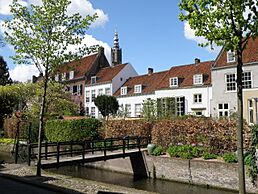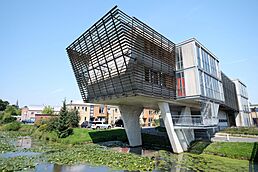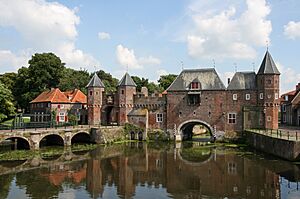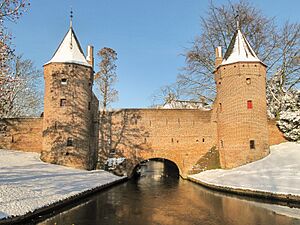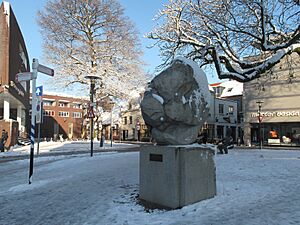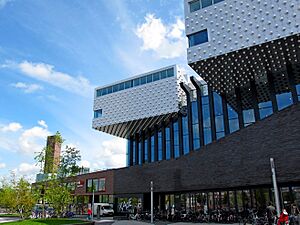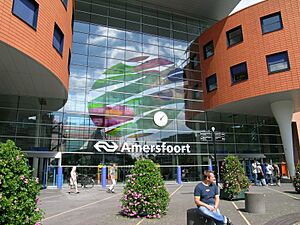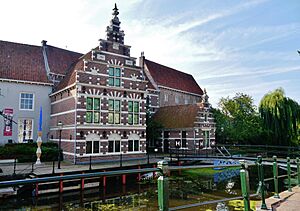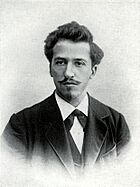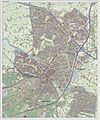Amersfoort facts for kids
Quick facts for kids
Amersfoort
|
|||||
|---|---|---|---|---|---|
|
City and municipality
|
|||||
|
Zuidsingel
Lieve Vrouwekerkhof
Havik
Woudzoom
|
|||||
|
|||||
| Nickname(s):
Keistad (Boulder City)
|
|||||
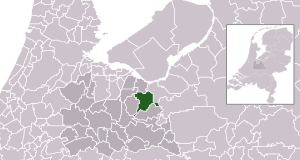
Location in Utrecht
|
|||||
| Country | Netherlands | ||||
| Province | Utrecht | ||||
| City rights | 1259 | ||||
| Government | |||||
| • Body | Municipal council | ||||
| Area | |||||
| • Municipality | 63.86 km2 (24.66 sq mi) | ||||
| • Land | 62.86 km2 (24.27 sq mi) | ||||
| • Water | 1.00 km2 (0.39 sq mi) | ||||
| Elevation | 3 m (10 ft) | ||||
| Population
(Municipality, May 2014; Urban and Metro, May 2014)
|
|||||
| • Municipality | 151,534 | ||||
| • Density | 2,411/km2 (6,240/sq mi) | ||||
| • Urban | 180,539 | ||||
| • Metro | 287,110 | ||||
| Demonym(s) | Amersfoorter(s) | ||||
| Time zone | UTC+1 (CET) | ||||
| • Summer (DST) | UTC+2 (CEST) | ||||
| Postcode |
3800–3829
|
||||
| Area code | 033 | ||||
| Click on the map for a fullscreen view | |||||
Amersfoort is a lively city and municipality in the Utrecht province of the Netherlands. As of January 2023, over 160,000 people live here. This makes it the second-largest city in its province and the fifteenth-largest in the country.
Amersfoort is a very important hub for trains in the Netherlands. It has three railway stations: Amersfoort Centraal, Schothorst, and Vathorst. These stations connect major railway lines across the country. In 1928, Amersfoort even hosted some events for the 1928 Summer Olympics. The city celebrated its 750th birthday in 2009!
Contents
Discovering Amersfoort's Past
Amersfoort has a long and interesting history, going back thousands of years.
Early Settlements and City Beginnings
Long ago, during the Mesolithic period, hunter-gatherers camped in the Amersfoort area. Archaeologists have found traces of their camps, like old fireplaces and stone tools. Later, around 1000 BC, people built more permanent homes here.
The name Amersfoort comes from a "ford" (a shallow place to cross) in the Amer River, which is now called the Eem. The city started to grow around a place called the Hof. This is where the Bishops of Utrecht set up a court to control the nearby area. In 1259, the bishop of Utrecht, Henry I van Vianden, gave Amersfoort its "city rights." This meant it had special permissions to govern itself and build defenses.
Building the City Walls
Around 1300, the first brick wall was built to protect the city. As Amersfoort grew, a new, larger wall was started in 1380 and finished around 1450. The famous Koppelpoort is a special gate that was part of this second wall. It could be used for both land and water traffic. The first wall was later taken down, and houses were built where it once stood. Today, the street Muurhuizen (meaning "wall-houses") is located exactly where that first wall used to be.
The Tall Tower of Our Lady
The Onze-Lieve-Vrouwentoren (Tower of Our Lady) is one of the tallest medieval church towers in the Netherlands. It stands at 98 meters (322 feet) tall! Its nickname is Lange Jan, which means 'Long John'.
Building the tower and its church began in 1444. Sadly, the church was destroyed by an explosion in 1787. But the tower survived! You can still see where the church used to be because the ground is paved with different types of stone. This tower is also very important because it's the central point for the Dutch map system, called the RD coordinate system.
Amersfoort in the Middle Ages
The inner city of Amersfoort still looks much like it did in the Middle Ages. Besides the tower, the Koppelpoort, and the Muurhuizen, you can also see the Sint-Joriskerk (Saint George's church) and a system of canals with old bridges. Many of these old buildings are protected as national monuments.
In the Middle Ages, Amersfoort was known for its textile industry and many breweries.
Why Amersfoort is Called 'Boulder City'
Amersfoort's nickname is Keistad, which means "boulder-city." This comes from a funny story about the Amersfoortse Kei (Amersfoort Boulder). In 1661, 400 people dragged a huge 9-ton (18,000-pound) boulder from the nearby Soest moors into the city. They did this because of a bet between two landowners! The winner bought everyone beer and pretzels as a reward.
Other towns started calling the people of Amersfoort Keientrekker (boulder-puller). This embarrassed the locals, so they buried the boulder in 1672. But in 1903, it was found again and placed in a special spot as a monument. This unique boulder is now a symbol of the city.
Growth and Challenges
In the 18th century, Amersfoort thrived because of tobacco farming. However, around 1800, the city started to decline. This changed when the first railway line was built in 1863. Later, many military barracks were built to protect the western cities of the Netherlands, which also helped the city grow.
After the 1920s, growth slowed down again. In 1970, the government decided to make Amersfoort a "growth city" to encourage more people to move there.
Amersfoort During World Wars
During the First World War, many refugees from Belgium found shelter in Amersfoort and nearby areas. A monument called the "Belgenmonument" remembers this time and the difficulties the Belgian refugees faced.
Before the Second World War, Amersfoort was a large military town. When the Germans invaded in May 1940, the entire population of 43,000 people had to leave. After four days of fighting, they were allowed to return.
Sadly, the Jewish community in Amersfoort suffered greatly during the war. Many were taken away and killed. The city's synagogue, built in 1727, was badly damaged but was later restored and reopened after the war. There was also a Nazi concentration camp near Amersfoort, called Kamp Amersfoort. It was actually located in the neighboring town of Leusden.
Culture and Fun in Amersfoort
Museums to Explore
Amersfoort has several interesting museums:
- The Mondriaan House: This is the birthplace of the famous painter Piet Mondriaan. You can see a life-size copy of his workshop in Paris and art inspired by him.
- Flehite: This museum has historical, educational, and temporary art exhibits. It reopened in 2009 after being renovated.
- Dutch Cavalry Museum: Located in old barracks, this museum shows the history of Dutch cavalry and tanks.
- Kunsthal KAdE: A modern art exhibition hall that features different types of contemporary art.
Sports and Recreation
Amersfoort used to have its own professional football (soccer) club, HVC Amersfoort, but it closed in 1982. The city hosted the riding part of the modern pentathlon for the 1928 Olympics. From 2002 to 2008, Amersfoort also hosted the Dutch Open (tennis) tournament.
The city is home to the baseball and softball club Quick Amersfoort. Their top men's baseball team plays in the highest league in the Netherlands. Amersfoort is also the hometown of the famous track and field athlete Femke Bol.
Popular Landmarks
The DierenPark Amersfoort zoo is a popular attraction that was founded in 1948. It's a great place to see animals and learn about wildlife.
Getting Around Amersfoort
Bus Services
Bus services in Amersfoort are provided by two companies: U-OV and Syntus. Syntus covers routes within the town and the province of Utrecht, except for the bus to Utrecht city, which is run by U-OV.
Train Connections
Amersfoort has three railway stations, making it a major train hub:
- Amersfoort Centraal: This is the main station, located on the western side of the city. It connects major railway lines.
- Amersfoort Schothorst: Located northeast of the city center.
- Amersfoort Vathorst: Found in the far northeast of the city.
All three stations have direct trains to Utrecht Centraal and Zwolle. Amersfoort Centraal and Schothorst also offer direct services to Den Haag Centraal, Amsterdam Centraal, and Amsterdam Zuid. Amersfoort Centraal also connects to cities like Enschede, Rotterdam Centraal, Schiphol Airport, and even Berlin Hauptbahnhof in Germany.
Roads and Waterways
Two main highways pass by Amersfoort: the A1 motorway to the north (connecting Amsterdam and Apeldoorn) and the A28 motorway to the east (connecting Utrecht and Groningen).
The Eem river starts in Amersfoort, and the city has a port for boats that transport goods. The Eem river connects to the nearby Eemmeer (Lake Eem).
Amersfoort's Economy
Amersfoort is home to several important international companies and organizations.
Major Companies
Some of the big companies based in Amersfoort include:
- Royal VolkerWessels Stevin N.V.: A large European construction company.
- FrieslandCampina: A Dutch company known for its dairy products.
- Royal HaskoningDHV: A company of consultants and engineers.
- Golden Tulip Hospitality Group: An international hotel chain.
- Nutreco: A company that produces animal feed and human food.
- Yokogawa Electric: An electrical engineering and software company, with its European headquarters in Amersfoort.
Important Organizations
Amersfoort also hosts several non-governmental organizations and foundations:
- Christian Union: A Christian democratic political party.
- Oikocredit: A global organization that helps finance economic development to reduce poverty.
- Socialist Party: A left-wing political party in the Netherlands.
- KNLTB: The Dutch national tennis association.
- Vereniging Eigen Huis: The largest home-owners association in the Netherlands.
Famous People from Amersfoort
Many notable people have come from Amersfoort, including artists, athletes, and public figures.
- Piet Mondriaan (1872–1944) – A very famous painter, known for his abstract art.
- Johannes Heesters (1903–2011) – A well-known actor and singer.
- Ben Pon (senior) (1904–1968) – A car importer who helped develop the Volkswagen Type 2.
- Gino Vannelli (born 1952) – A Canadian singer, songwriter, and musician.
- Blaudzun (born 1974) – A singer and filmmaker.
- Femke Bol (born 2000) – A talented Dutch hurdler and sprinter.
- Puck Pieterse (born 2002) – A Dutch cyclist.
Sister City
Amersfoort has a special connection with another city:
Images for kids
See also
 In Spanish: Amersfoort para niños
In Spanish: Amersfoort para niños


